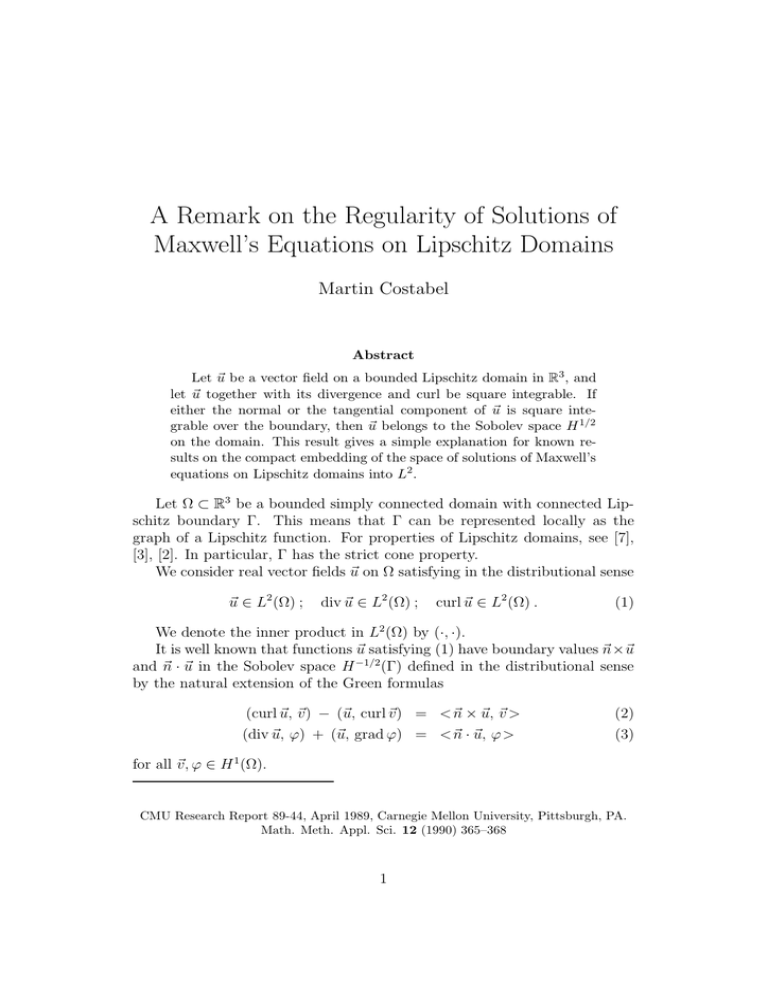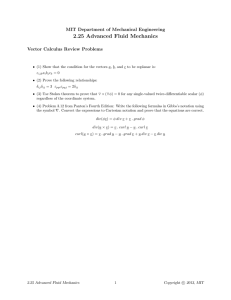A Remark on the Regularity of Solutions of Maxwell`s Equations on
advertisement

A Remark on the Regularity of Solutions of Maxwell’s Equations on Lipschitz Domains Martin Costabel Abstract Let ~u be a vector field on a bounded Lipschitz domain in R3 , and let ~u together with its divergence and curl be square integrable. If either the normal or the tangential component of ~u is square integrable over the boundary, then ~u belongs to the Sobolev space H 1/2 on the domain. This result gives a simple explanation for known results on the compact embedding of the space of solutions of Maxwell’s equations on Lipschitz domains into L2 . Let Ω ⊂ R3 be a bounded simply connected domain with connected Lipschitz boundary Γ. This means that Γ can be represented locally as the graph of a Lipschitz function. For properties of Lipschitz domains, see [7], [3], [2]. In particular, Γ has the strict cone property. We consider real vector fields ~u on Ω satisfying in the distributional sense ~u ∈ L2 (Ω) ; div ~u ∈ L2 (Ω) ; curl ~u ∈ L2 (Ω) . (1) We denote the inner product in L2 (Ω) by (·, ·). It is well known that functions ~u satisfying (1) have boundary values ~n ×~u and ~n · ~u in the Sobolev space H −1/2 (Γ) defined in the distributional sense by the natural extension of the Green formulas (curl ~u, ~v ) − (~u, curl ~v ) = <~n × ~u, ~v > (div ~u, ϕ) + (~u, grad ϕ) = <~n · ~u, ϕ > (2) (3) for all ~v , ϕ ∈ H 1 (Ω). CMU Research Report 89-44, April 1989, Carnegie Mellon University, Pittsburgh, PA. Math. Meth. Appl. Sci. 12 (1990) 365–368 1 Here ~n denotes the exterior normal vector which exists almost everywhere on Γ, and < ·, · > is the natural duality in H −1/2 (Γ) × H 1/2 (Γ) extending the L2 (Γ) inner product. It is known that for smooth domains (e.g., Γ ∈ C 1,1 ), each one of the two boundary conditions ~n × ~u ∈ H 1/2 (Γ) or ~n · ~u ∈ H 1/2 (Γ) (4) implies ~u ∈ H 1 (Ω), see [2] and, for the case of homogeneous boundary conditions, [6], where one finds also a counterexample for a nonsmooth domain. Such counterexamples are derived from nonsmooth weak solutions v ∈ H 1 (Ω) of the Neumann problem (∂n := ~n · grad denotes the normal derivative) ∆v = g ∈ L2 (Ω) ; ∂n v = 0 on Γ (5) If ~u = grad v, then ~u satisfies (1) and ~n · ~u = 0 on Γ, and ~u ∈ H s (Ω) if and only if v ∈ H 1+s (Ω). For smooth or convex domains, one knows that v ∈ H 2 (Ω). If Ω has a nonconvex edge of opening angle απ, α > 1, then, in general, the solution v of (5) is not in H 1+s (Ω) for s = 1/α, hence ~u 6∈ H s (Ω). This upper bound s for the smoothness of ~u can be arbitrary close to 1/2. Regularity theorems for (1), (4) have applications in the numerical approximation of the Stokes problem [2] and in the analysis of initial-boundary value problems for Maxwell’s equations [6]. The compact embedding into L2 (Ω) of the space of solutions of the time-harmonic Maxwell equations is needed for the principle of limiting absorption. This compact embedding result was shown by Weck [10] for a class of piecewise smooth domains and by Weber [9] and Picard [8] for general Lipschitz domains. In these proofs, no regularity result for the solution ~u was used or obtained. See Leis’ book [6] for a discussion. In this note, we use the result by Dahlberg, Jerison, and Kenig [4], [5] on the H 3/2 regularity for solutions of the Dirichlet and Neumann problems with L2 data in potential theory (see Lemma 1 below). Together with arguments similar to those described by Girault and Raviart [2], this yields ~u ∈ H 1/2 (Ω) (Theorem 2). The compact embedding in L2 is an obvious consequence of this regularity. If instead of Lemma 1, one uses only the more elementary tools from [1], one obtains H 3/2−ǫ regularity for solutions of the Dirichlet and Neumann problems in potential theory and, consequently ~u ∈ H 1/2−ǫ (Ω) for any ǫ > 0. This kind of regularity is also known for the case of an open manifold Γ (screen problem). It suffices, of course, for the compact embedding result. The proof of the following result can be found in [4]. 2 Lemma 1 (Dahlberg-Jerison-Kenig) Let v ∈ H 1 (Ω) satisfy ∆v = 0 in Ω. Then the two conditions (i) v ↾Γ ∈ H 1 (Γ) and (ii) ∂n v ↾Γ ∈ L2 (Γ) are equivalent. They imply v ∈ H 3/2 (Ω). Remarks. a.) The first assertion in the Lemma goes back to Nečas [7]. b.) There are accompanying norm estimates, viz. There exist constants C1 , C2 , C3 , independent of v such that C1 k∂n vkL2 (Γ) ≤ k~n × grad vkL2 (Γ) ≤ C2 k∂n vkL2 (Γ) , kvkH 3/2 (Ω) ≤ C3 kv ↾Γ kH 1 (Γ) . c.) The boundary values are attained in a stronger sense than the distributional sense (2), (3), namely pointwise almost everywhere in the sense of nontangential maximal functions in L2 (Γ). Theorem 2 Let ~u satisfy the conditions (1) in Ω and either ~n × ~u ∈ L2 (Γ) (6) ~n · ~u ∈ L2 (Γ) . (7) or Then ~u ∈ H 1/2 (Ω). If (1) is satisfied, then the two conditions (6) and (7) are equivalent. Proof. The proof follows the lines of [2]. It is presented in detail to make sure that it is valid for Lipschitz domains. Let f~ := curl ~u ∈ L2 (Ω). Then div f~ = 0 in Ω. According to [2, Ch. I, Thm 3.4] there exists w ~ ∈ H 1 (Ω) with curl w ~ = f~ , div w ~ =0 in Ω. (8) The construction of w ~ is as follows: Choose a ball O containing Ω in its interior and solve in O \ Ω the Neumann problem: χ ∈ H 1 (O \ Ω) with ∆χ = 0 in O \ Ω ; ∂n χ = ~n · f~ on Γ ; ∂n χ = 0 on ∂O . (9) Note that ~n · f~ ∈ H −1/2 (Γ) satisfies the solvability condition <~n · f~, 1> = 0 because div f~ = 0 in Ω. 3 Define f~0 := f~ in Ω, f~0 := grad χ in O\Ω, f~0 := 0 in R3 \O. Then f~0 ∈ L2 (R3 ) has compact support and satisfies div f~0 = 0 in R3 . Therefore f~0 = curl w ~ for some w ~ ∈ H 1 (R3 ) with div w ~ = 0 in R3 . One obtains w ~ for example by convolution of f~0 with a fundamental solution of the Laplace operator in R3 and taking the curl. Thus (8) is satisfied. The function ~z := ~u − w ~ satisfies ~z ∈ L2 (Ω) and curl ~z = 0 in Ω. (10) Since Ω is simply connected, there exists v ∈ H 1 (Ω) with ~z = grad v . (11) ∆v = div ~u ∈ L2 (Ω) . (12) Then v satisfies We can apply Lemma 1 to v, because by subtraction of a suitable function in H 2 (Ω) , we obtain a homogeneous Laplace equation from (12). Now, since w ~ ↾Γ ∈ H 1/2 (Γ), condition (i) in the Lemma is equivalent to ~n × grad v = ~n × ~z = ~n × ~u − ~n × w ~ ∈ L2 (Γ) and hence to (6), and condition (ii) is equivalent to ~n · grad v = ~n · ~z = ~n · ~u − ~n · w ~ ∈ L2 (Γ) and hence to (7). Therefore the Lemma implies that (6) and (7) are equivalent. Also, v ∈ H 3/2 (Ω) is equivalent to grad v ∈ H 1/2 (Ω), hence to ~u = ~z + w ~ = grad v + w ~ ∈ H 1/2 (Ω) . Remark. The accompanying norm estimates are: There exist constants C1 , C2 , C3 , independent of ~u such that k~n × ~ukL2 (Γ) ≤ C1 k~ukL2 (Ω) + k div ~ukL2 (Ω) + k curl ~ukL2 (Ω) + k~n · ~ukL2 (Γ) k~n · ~ukL2 (Γ) ≤ C2 k~ukL2 (Ω) + k div ~ukL2 (Ω) + k curl ~ukL2 (Ω) + k~n × ~ukL2 (Γ) k~ukH 1/2 (Ω) ≤ C3 k~ukL2 (Ω) + k div ~ukL2 (Ω) + k curl ~ukL2 (Ω) + k~n × ~ukL2 (Γ) . 4 References [1] M. Costabel. Boundary integral operators on Lipschitz domains: Elementary results. SIAM J. Math. Anal. 19 (1988) 613–626. [2] V. Girault, P. Raviart. Finite Element Methods for Navier-Stokes Equations. Springer-Verlag, Berlin 1986. [3] P. Grisvard. Boundary Value Problems in Non-Smooth Domains. Pitman, London 1985. [4] D. S. Jerison, C. E. Kenig. The Neumann problem on Lipschitz domains. Bull. Amer. Math. Soc. 4 (1981) 203–207. [5] D. S. Jerison, C. E. Kenig. Boundary value problems on Lipschitz domains. In W. Littmann, editor, Studies in Partial Differential Equations. MAA Studies in Mathematics 23, pages 1–68. Math. Assoc. of America, Washington, D. C. 1982. [6] R. Leis. Initial Boundary Value Problems in Mathematical Physics. John Wiley & Sons, Chichester 1986. [7] J. Nečas. Les Méthodes Directes en Théorie des Equations Elliptiques. Masson, Paris 1967. [8] R. Picard. An elementary proof for a compact imbedding result in generalized electromagnetic theory. Math. Z. 187 (1984) 151–164. [9] C. Weber. A local compactness theorem for Maxwell’s equations. Math. Meth. Appl. Sci. 2 (1980) 12–25. [10] N. Weck. Maxwell’s boundary value problem on Riemannian manifolds with nonsmooth boundaries. J. Math. Anal. Appl. 46 (1974) 410–437. 5



